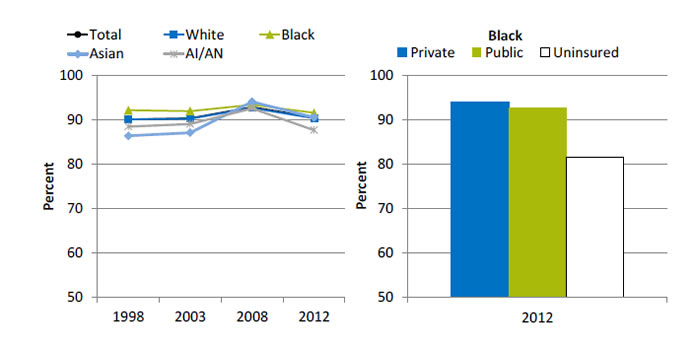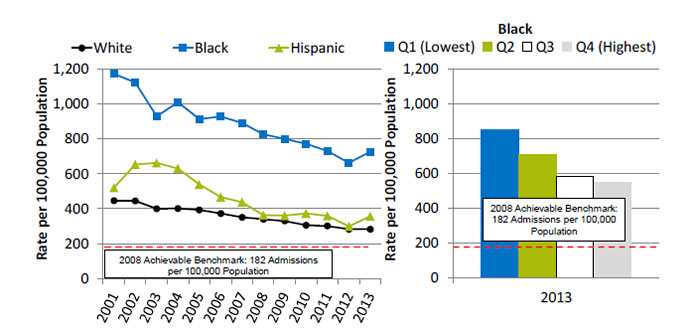- Thirty years ago, the Heckler Report found that:
- Cardiovascular disease (CVD) was a major cause of death in Blacks, and the rate was higher than in Whites.
- There appeared to be a strong inverse relationship between socioeconomic status (SES) and hypertension in Blacks, similar to that found for Hispanics and Whites.
- Diabetes mellitus was a major problem in Blacks.
- The generally higher prevalence of obesity, noninsulin-dependent diabetes, hypertension, high low-density lipoprotein (LDL) cholesterol and low high-density lipoprotein (HDL) cholesterol levels in Blacks might be expected to increase their CVD risk.
Cardiovascular Care for Blacks
| Measure | Most Recent Disparity | Disparity Change |
|---|---|---|
| Adults who received a blood pressure measurement in the last 2 years and can state whether their blood pressure was normal or high | Same | No Change |
| Adult admissions for hypertension | Same | No Change |
| Adult admissions for angina without cardiac procedure | Worse | No Change |
| Adult admissions for congestive heart failure | Worse | No Change |
| Hospital patients with heart attack given fibrinolytic medication within 30 minutes of arrival | Same | No Change |
- Trends: Most measures of cardiovascular care for Blacks were improving.
- Groups With Disparities:
- The rates between Blacks and Whites were similar for those who received their blood pressure measurement and for hypertension admissions. These disparities did not change over time.
- Blacks had higher rates of admission than Whites for angina and congestive heart failure and these disparities did not change over time.
- Blacks and Whites had similar rates of receipt of fibrinolytic medication for heart attack and these disparities did not change over time.
Blood Pressure Measurement
Adults who received a blood pressure measurement in the last 2 years and can state whether their blood pressure was normal or high, by race, 1998-2012, and by insurance, Blacks, 2012

Left Chart:
| Race | 1998 | 2003 | 2008 | 2012 |
|---|---|---|---|---|
| Total | 90.1 | 90.4 | 92.9 | 90.6 |
| Black | 92.2 | 92.0 | 93.4 | 91.6 |
| White | 90.1 | 90.3 | 92.7 | 90.4 |
| AI/AN | 88.5 | 89.1 | 92.6 | 87.7 |
| Asian | 86.4 | 87.1 | 94.1 | 90.6 |
Right Chart (Insurance, Blacks, 2012):
- Private - 93.9.
- Public - 92.7.
- Uninsured - 81.5.
Key: AI/AN = American Indian or Alaska Native.
Source: Centers for Disease Control and Prevention, National Center for Health Statistics, National Health Interview Survey, 1998-2012.
Denominator: Adult civilian noninstitutionalized population.
Note: Measure is age adjusted. Racial groups refer to single race (e.g., White only).
- Importance: Early detection and treatment of high blood pressure can prevent heart failure, kidney failure, and stroke. Because high blood pressure typically causes no symptoms, screening is essential.
- Trends: From 1998 to 2012, the percentage of adults who received a blood pressure measurement in the last 2 years and can state whether their blood pressure was normal or high did not change overall or for any racial/ethnic group.
- Groups With Disparities:
- In 2 of 4 years, Black adults were more likely than Whites to receive a blood pressure measurement. In 2 of 4 years, Asian adults were less likely than Whites to receive a blood pressure measurement.
- In 2012, uninsured Black adults (81.5%) were less likely than Black adults with private insurance (93.9%) to receive a blood pressure measurement.
Admissions for Congestive Heart Failure
Adult admissions for congestive heart failure per 100,000 population, by race, 2001-2013, and by area income, Blacks, 2013

Left Chart:
| Year | White | Black | Hispanic |
|---|---|---|---|
| 2001 | 445.4 | 1169.8 | 519.5 |
| 2002 | 444.1 | 1121.8 | 653.0 |
| 2003 | 399.5 | 927.8 | 662.2 |
| 2004 | 400.9 | 1009.3 | 629.9 |
| 2005 | 392.8 | 912.4 | 538.0 |
| 2006 | 373.0 | 927.5 | 465.9 |
| 2007 | 350.8 | 890.2 | 437.1 |
| 2008 | 339.9 | 824.6 | 362.8 |
| 2009 | 329.7 | 799.3 | 360.2 |
| 2010 | 306.3 | 771.4 | 372.7 |
| 2011 | 301.1 | 730.5 | 359.2 |
| 2012 | 283.2 | 662.2 | 298.9 |
| 2013 | 282.5 | 726.2 | 356.7 |
Right Chart (Income, Blacks, 2013):
- Q1 (Lowest) - 851.1.
- Q2 - 707.
- Q3 - 581.4.
- Q4 (Highest) - 544.7.
2008 Achievable Benchmark: 182 Admissions per 100,000 Population.
Key: Q1 represents the lowest income quartile and Q4 represents the highest income quartile based on the median income of a patient's ZIP Code of residence.
Source: Agency for Healthcare Research and Quality, Healthcare Cost and Utilization Project, State Inpatient Databases, 2001‐2013 quality and disparities analysis files and AHRQ Quality Indicators, modified version 4.4.
Denominator: U.S. resident population age 18 and over.
Note: For this measure, lower rates are better. White and Black are non-Hispanic. Hispanic includes all races.
- Importance: Racial disparities in care for congestive heart failure have been observed.
- Trends: From 2002 to 2013, the rate of admission for congestive heart failure among adults decreased significantly for all racial/ethnic groups.
- Groups With Disparities:
- In all years, compared with Whites, Blacks had higher rates of admission for congestive heart failure. In 10 of 12 years, the rates of admission for congestive heart failure were higher among Hispanics compared with Whites.
- In 2013, poor (851.1 per 100,000) and low-income (707.0 per 100,000) Black adults had higher rates of admission for congestive heart failure compared with Black adults with high income (544.7 per 100,000).
- Achievable Benchmark:
- The 2008 top 4 State achievable benchmark for adult congestive heart failure admissions was 182 admissions per 100,000 population. The top 4 States that contributed to the achievable benchmark are Colorado, Utah, Vermont, and Wyoming.
- At current rates of improvement, it would take the overall rate 10 years to achieve the benchmark, Blacks could achieve the benchmark in 15 years, Whites could achieve it in 7 years, and Hispanics would need 6 years to achieve the benchmark.
Heart Attack Patients Given Fibrinolytic Medication
Hospital patients with heart attack given fibrinolytic medication within 30 minutes of arrival, by race, 2005-2013

| Race | 2005 | 2006 | 2007 | 2008 | 2009 | 2010 | 2011 | 2012 | 2013 |
|---|---|---|---|---|---|---|---|---|---|
| Total | 37.9 | 42.1 | 50.0 | 49.4 | 54.4 | 58.4 | 57.9 | 62.3 | 54.3 |
| White | 38.7 | 43.6 | 51.8 | 51.0 | 55.7 | 63.8 | 57.3 | 62.5 | 55.9 |
| Black | 27.7 | 32.6 | 44.5 | 37.8 | 46.8 | 53.0 | 58.2 | 58.5 | 51.4 |
Source: Centers for Medicare & Medicaid Services, Medicare Quality Improvement Organization Program, 2005-2013.
Denominator: Discharged hospital patients with a principal diagnosis of acute myocardial infarction and documented receipt of thrombolytic therapy during the hospital stay.
- Importance: Some heart attacks are caused by blood clots. Early actions, such as fibrinolytic medication, may open blockages caused by blood clots, reduce heart muscle damage, and save lives. To be effective, these actions need to be performed quickly after the start of a heart attack.
- Trends: From 2005 to 2013, the percentage of patients who received timely fibrinolytic medication improved overall (27.7% to 51.4%).
- Groups With Disparities: In 6 of 9 years, the percentage of patients who received timely fibrinolytic medication was lower for Blacks than for Whites.
Outcomes of Cardiovascular Care for Blacks
| Measure | Most Recent Disparity | Disparity Change |
|---|---|---|
| Deaths per 1,000 hospital admissions with acute myocardial infarction (AMI), age 18+ | Better | No Change |
| Deaths per 1,000 hospital admissions with congestive heart failure (CHF), age 18+ | Better | No Change |
| Deaths per 1,000 hospital admissions with abdominal aortic aneurysm repair, age 18+ | Better | Narrowing |
| Deaths per 1,000 hospital admissions with coronary artery bypass graft, age 40+ | Same | No Change |
| Deaths per 1,000 hospital admissions with percutaneous transluminal coronary angioplasty, age 40+ | Better | No Change |
- Trends: Most measures of cardiovascular-related deaths among Blacks were improving.
- Groups With Disparities:
- The death rates for Blacks were better compared with Whites when hospitalized for:
- Acute myocardial infarction.
- Congestive heart failure.
- Abdominal aortic aneurysm repair.
- Percutaneous transluminal coronary angioplasty.
- The death rates for Blacks and Whites were similar for hospital admissions with coronary artery bypass graft. This disparity did not change over time.
- The disparities between Blacks and Whites did not change over time for all measures except deaths per 1,000 hospital admissions for abdominal aortic aneurysm repair, which narrowed.
- The death rates for Blacks were better compared with Whites when hospitalized for:
Inpatient Deaths Among Adult Admissions With Heart Attack
Inpatient deaths per 1,000 adult hospital admissions with heart attack, by race/ethnicity, 2001-2013

| Year | White | Black | Hispanic |
|---|---|---|---|
| 2001 | 98.7 | 92.2 | 97.2 |
| 2002 | 95.5 | 85.5 | 92.0 |
| 2003 | 86.9 | 81.6 | 86.6 |
| 2004 | 81.8 | 72.9 | 78.8 |
| 2005 | 76.9 | 65.2 | 75.2 |
| 2006 | 71.2 | 59.2 | 70.4 |
| 2007 | 65.4 | 55.8 | 63.6 |
| 2008 | 59.1 | 46.8 | 57.6 |
| 2009 | 53.7 | 46.1 | 57.5 |
| 2010 | 51.7 | 46.7 | 53.6 |
| 2011 | 50.5 | 42.1 | 48.1 |
| 2012 | 48.3 | 43.0 | 48.0 |
| 2013 | 46.1 | 38.3 | 46.4 |
2012 Achievable Benchmark: 41 Deaths per 1,000 Admissions.
Source: Agency for Healthcare Research and Quality, Healthcare Cost and Utilization Project, State Inpatient Databases, 2001‐2013 quality and disparities analysis files and AHRQ Quality Indicators, modified version 4.4.
Denominator: Adults age 18 and over admitted to a non-Federal community hospital in the United States with acute myocardial infarction as principal discharge diagnosis.
Note: For this measure, lower rates are better. Rates are adjusted by age, major diagnostic category, all payer refined-diagnosis related group risk of mortality score, and transfers into the hospital. Black and White are non-Hispanic. Hispanic includes all races.
- Importance: Racial disparities in heart attack care have been observed.
- Trends: From 2001 to 2013, the risk-adjusted inpatient mortality rate for hospital admissions with heart attack decreased significantly overall (data not shown) and for all racial/ethnic groups.
- Groups With Disparities: In 9 of 12 years, Black patients had lower inpatient mortality rates than Whites for hospital admissions with heart attack.
- Achievable Benchmark:
- The 2008 top 4 State achievable benchmark for inpatient heart attack mortality was 48 deaths per 1,000 admissions. By 2012, this benchmark had been attained overall and for all racial/ethnic groups.
- Because the 2008 benchmark was achieved by the total population, a new 2012 top 4 State achievable benchmark was set at 41 deaths per 1,000 admissions. The top 4 States that contributed to the achievable benchmark are Alaska, Arizona, Michigan, and Rhode Island.
- Blacks have already achieved the benchmark. At current rates of improvement, Whites could achieve the benchmark in a year and Hispanics in less than a year.
AHRQ Health Care Innovations in Cardiovascular Disease
Aetna's Racial and Ethnic Equality Initiative
- Population: Black Aetna members.
- Location: All 50 States.
- Intervention: Disease management program targeting Blacks that combines home blood pressure monitoring with culturally appropriate counseling and education.
- Outcomes: Significantly improved self-monitoring and blood pressure control.



